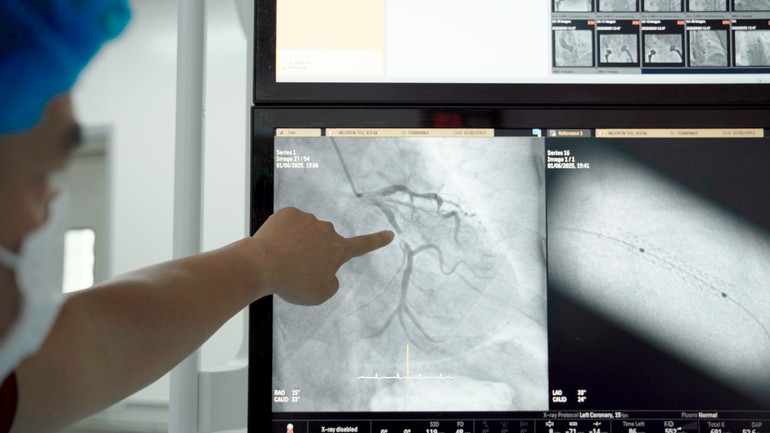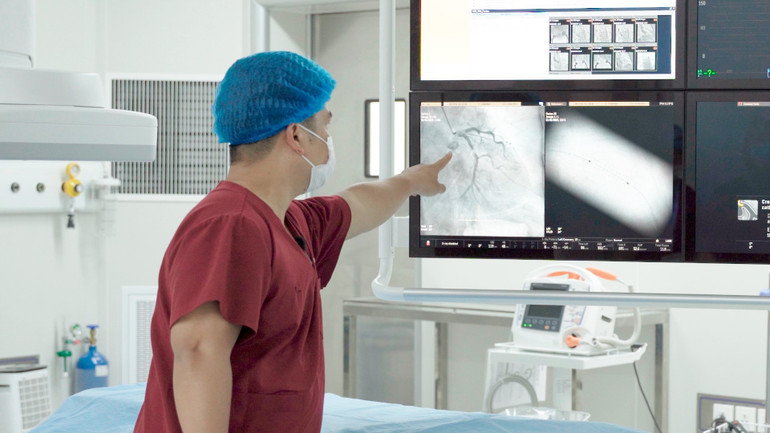
The female patient (72 years old) was taken to the emergency room at Phenikaa University Hospital in critical condition. Before that, the patient suddenly had typical symptoms of acute myocardial infarction: dizziness, chest tightness, shortness of breath, severe chest pain from behind the sternum spreading to the neck, accompanied by frequent vomiting at home.
At PhenikaaMec Emergency Resuscitation Center, doctors quickly examined and determined that the patient had an acute myocardial infarction with dangerous arrhythmia complications on the electrocardiogram (double ventricular extrasystoles with non-sustained ventricular tachycardia). It was impossible to know that the artery was nearly blocked by a blood clot without coronary angiography.
Faced with the most urgent situation, an interdisciplinary consultation was immediately conducted. The medical team from the Cardiovascular Center and PhenikaaMec's Emergency Resuscitation Center quickly coordinated, implemented intervention measures such as infusing antiarrhythmic drugs, using antithrombotic drugs immediately, and quickly transferred the patient to the vascular intervention room (Cathlab). The primary goal was to clear the coronary artery flow and restore blood flow to the heart as soon as possible to save the patient's life.

Master, Doctor Nguyen Danh Quy and the intervention team of PhenikaaMec Cardiovascular Center performed coronary angiography and discovered a blood clot blocking a branch of the coronary artery (circumflex artery).
Immediately after coronary angiography, the patient experienced ventricular fibrillation and cardiac arrest. The intervention team immediately performed cardioversion and chest compressions. After emergency treatment, the patient's pulse returned to stable hemodynamics. The intervention team immediately decided to aspirate the thrombus and place a stent to completely resolve the blockage.
However, during the procedure, the patient continued to have ventricular fibrillation and cardiac arrest again and the intervention team performed both cardiopulmonary resuscitation and stent placement.

Thanks to the tireless efforts and smooth coordination, the coronary stent intervention was successful. The patient continued to receive continuous infusion of anti-arrhythmic drugs, and the patient gradually regained full consciousness and stable hemodynamics. Immediately after that, the patient fully recovered, no difficulty breathing, only fatigue, mild chest tightness when exerting, and could eat, drink and talk normally.
This emergency patient case is a warning bell for the community about cardiovascular diseases, especially acute myocardial infarction. The disease can progress rapidly and be life-threatening, especially in the elderly.
Cardiovascular diseases are becoming younger. Regardless of age, maintaining a healthy lifestyle, working and resting regularly, eating a balanced diet and exercising regularly is very important. However, this is not enough to ensure a healthy heart.

Cardiovascular experts recommend that the community should perform regular cardiovascular screening to detect early signs of risk, especially for those with a family history of cardiovascular disease, those who smoke, drink a lot of alcohol, stay up late, work under stress, or those with underlying diseases such as high blood pressure or diabetes.
Early screening is the most effective measure for prevention and timely treatment, helping every heartbeat to be cherished, and every person to live a healthy life.
Source: https://nhandan.vn/cuu-song-nguoi-benh-nhoi-mau-co-tim-va-ngung-tim-2-lan-thanh-cong-post908142.html



![[Photo] President Luong Cuong attends the opening ceremony of the new school year at the National Defense Academy](https://vphoto.vietnam.vn/thumb/1200x675/vietnam/resource/IMAGE/2025/9/15/c65f03c8c2984e60bd84e6e01affa8a0)
![[Photo] General Secretary To Lam attends the 80th Anniversary of the General Department of Defense Industry](https://vphoto.vietnam.vn/thumb/1200x675/vietnam/resource/IMAGE/2025/9/15/fb8fd98417bb4ec5962de4f7fbfe0f6a)































































































Comment (0)